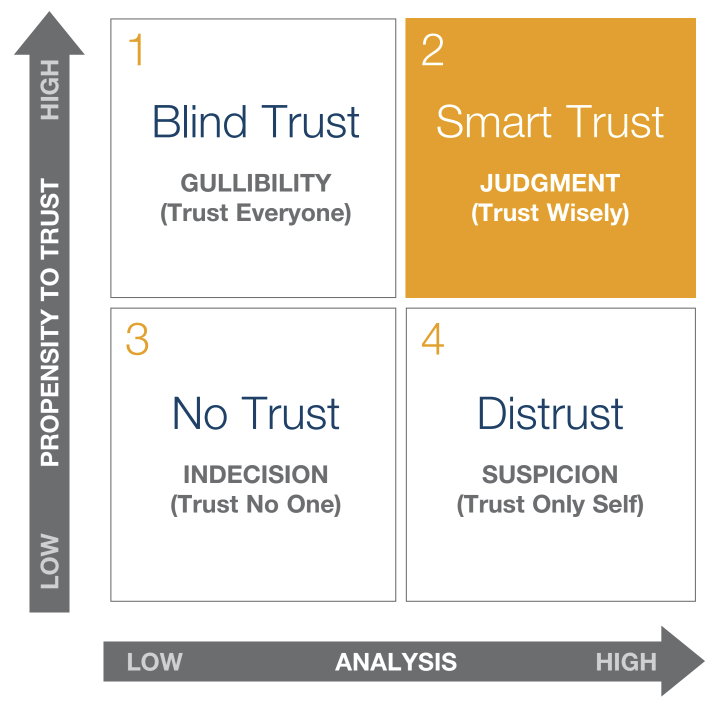
I am often guilty of the wrong kind of trust.
When I first saw Covey’s matrix (pictured above), I felt some discomfort. My propensity to trust is rather high, and my faith in humanity is so unconditional that my commitment to analysis is low.
So, according to the matrix, my high propensity to trust coupled with my low commitment to analysis? Covey calls this “Blind Trust.” In Blind Trust quadrant, Covey asserts people trust everything and everyone until they prove to be untrustworthy. The unkind word for this is gullible. Ouch. Now, I don’t think of myself as gullible. But, looking in the mirror and thinking back on some times I’ve let situations slide too long, I know I can do better.
How to counteract my blind trust.
First, I need to become familiar with the Smart Trust Matrix and understand behaviors related to The Speed of Trust. I suggest you take a look also, because there are two other traps besides Blind Trust that may fit your experiences better.
So, what have I learned? I’ve learned I need to take time to look at the behaviors of the people I’m about to trust blindly and see what trust-making behaviors I observe. (I promise we are just two weeks away from looking at those behaviors.)
Are you in the Distrust quadrant?
“But Alan,” you may be saying, “I’m not like you. Blind trust is not a problem for me, because the only person you can really trust is yourself.”
If you’re the opposite of me–you are very analytical and you have a low propensity to trust others–you may get trapped in the “Distrust” box. This bottom-right quadrant is the trap where you are constantly suspicious and trust only yourself. Because you can’t really know anyone, right?
What can Distrust person learn? You’ll be stuck when it comes to teamwork and synergy if you never trust. Moving into a higher propensity to trust can happen for you, but it’s important to learn and watch for those trust-making behaviors.
Or, are you in the No Trust quadrant?
Perhaps you’ve been burned so badly in the past that you don’t make time to analyze, and you have a low propensity to trust. This puts you in the bottom left, “No Trust” quadrant. It will be tough for you to move forward until you get past this state of indecision where you can trust yourself again. Here, you need to see yourself exhibit those trust-making behaviors before you can start watching for them in others.
Behavior is key.
I’ve been writing about behavior since the first few clumsy posts on this blog. In The Speed of Trust, Covey presents the “See-Speak-Behave” model.
The SEE, SPEAK, BEHAVE pieces don’t always go in order, but they interrelate.
We need to SEE the impact of trust. Look for those behaviors and their impact.
We must SPEAK the language of trust. We talk out loud to and about people in ways that improve trust, and make trust development an explicit objective.
And we BEHAVE in ways that inspire trust. Make Smart Trust happen in all directions.
Next week, we will outline those 13 behaviors before going into detail on each of them. We will start by looking at the Four Cores of Credibility.

Thanks for reading,
Alan Feirer

Leave a Reply